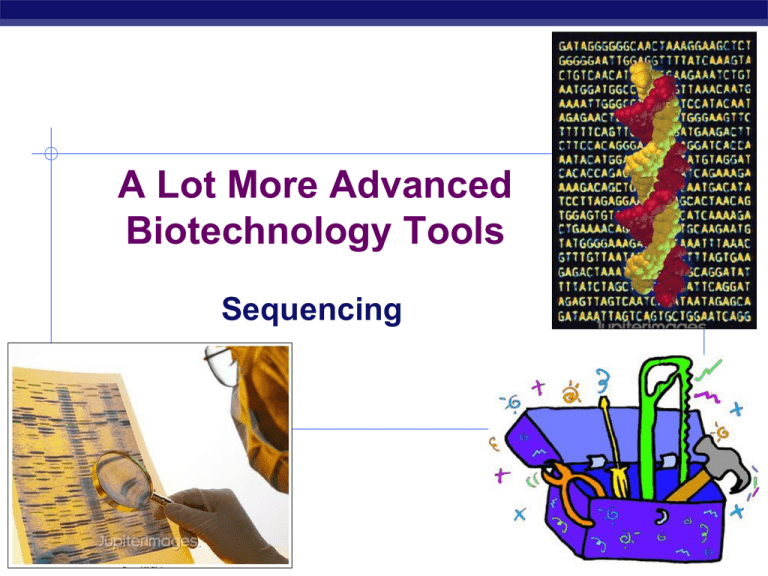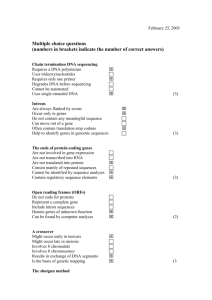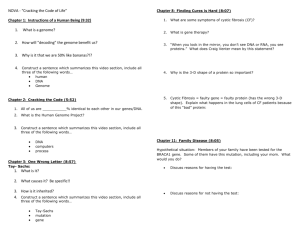A Lot More Advanced Biotechnology Tools Sequencing
advertisement

A Lot More Advanced Biotechnology Tools Sequencing 2007-2008 DNA SEQUENCING Sanger method (Fig. 20.12) determine the base sequence of DNA based on replication dideoxyribonucleotides ● ● ● ddATP, ddGTP, ddTTP, ddCTP missing O for bonding of next nucleotide terminates the growing chain * DNA SEQUENCING Sanger method synthesize complementary DNA strand in vitro in each tube: 1 ● ● “normal” N-bases Tagged dideoxy N-bases ●ddA, ddC, ddG, ddT 2 3 DNA polymerase primer buffers & salt 2 4 * READING THE SEQUENCE Load gel with sequences from ddA, ddT, ddC, ddG in separate lanes ● ● read lanes manually & carefully polyacrylamide gel * FRED SANGER 1978 | 1980 This was his 2nd Nobel Prize!! 1st was in 1958 for the structure of insulin ● * ADVANCEMENTS TO SEQUENCING Fluorescent tagging no more radioactivity all 4 bases in 1 lane ● ● each base a different color Automated reading * ADVANCEMENTS TO SEQUENCING Fluorescent tagging sequence data Computer read & analyzed * ADVANCEMENTS TO SEQUENCING Capillary tube electrophoresis ● ● no more pouring gels higher capacity & faster Applied Biosystems, Inc (ABI) built an industry on these machines 384 lanes * Big labs! ● PUBLIC Joint Genome Institute (DOE) MIT Washington University of St. Louis Baylor College of Medicine Sanger Center (UK) PRIVATE Celera Genomics economy of scale * AUTOMATED SEQUENCING MACHINES Really BIG labs! * HUMAN GENOME PROJECT U.S government project ● begun in 1990 estimated to be a 15 year project ● DOE & NIH initiated by Jim Watson led by Francis Collins goal was to sequence entire human genome ● 3 billion base pairs Celera Genomics ● ● ● Craig Venter challenged gov’t would do it faster, cheaper private company * DIFFERENT APPROACHES gov’t method “map-based method” Cut DNA segment into fragments, arrange based on overlapping nucleotide sequences, and clone fragments. 2. Cut and clone into smaller fragments. ● Craig Venter’s method “shotgun method” 1. Cut DNA entire chromosome into small fragments and clone. 2. Sequence each segment & arrange based on overlapping nucleotide sequences. 3. Assemble DNA sequence using overlapping sequences. * HUMAN GENOME PROJECT On June 26, 2001, HGP published the “working draft” of the DNA sequence of the human genome. Historic Event! blueprint of a human the potential to change science & medicine ● ● * SEQUENCE OF 46 HUMAN CHROMOSOMES 3G of data 3 billion base pairs * TACGCACATTTACGTACGCGGATGCCGCGACT ATGATCACATAGACATGCTGTCAGCTCTAGTA human genome GACTAGCTGACTCGACTAGCATGATCGATCAG 3.2 billion CTACATGCTAGCACACYCGTACATCGATCCTG ACATCGACCTGCTCGTACATGCTACTAGCTAC bases TGACTCATGATCCAGATCACTGAAACCCTAGA TCGGGTACCTATTACAGTACGATCATCCGATC AGATCATGCTAGTACATCGATCGATACTGCTA CTGATCTAGCTCAATCAAACTCTTTTTGCATCA TGATACTAGACTAGCTGACTGATCATGACTCT GATCCCGTAGATCGGGTACCTATTACAGTACG ATCATCCGATCAGATCATGCTAGTACATCGAT CGATACTGCTACTGATCTAGCTCAATCAAACT CTTTTTGCATCATGATACTAGACTAGCTGACT * RAW GENOME DATA * NCBI GENBANK Database of genetic sequences gathered from research Publicly available on Web! * ORGANIZING THE DATA * MAPS OF HUMAN GENES… Where the genes are… mapping genes & their mutant alleles ● * DEFINING A GENE… “Defining a gene is problematic because… one gene can code for several protein products, some genes code only for RNA, two genes can overlap, and there are many other complications.” protein gene – Elizabeth Pennisi, Science 2003 gene gene RNA polypeptide 1 polypeptide 2 polypeptide 3 It’s hard to hunt for wabbits, if you don’t know what a wabbit looks like. * AND WE DIDN’T STOP THERE… * THE PROGRESS 122+ bacterial genomes first metazoan complete (flatworm) first eukaryote complete (yeast) 17 eukaryotic gen First 2 bacterial genomes complete # of DNA base pairs (billions) in GenBank Data from NCBI and TIGR (www.ncbi.nlm.nih.gov(www.ncbi.nlm.nih. Official “15 year” Human Genome Project: 1990-2003. * HOW DOES THE HUMAN GENOME STACK UP? Organism Human (Homo sapiens) Laboratory mouse (M. musculus) Mustard weed (A. thaliana) Roundworm (C. elegans) Fruit fly (D. melanogaster) Yeast (S. cerevisiae) Bacterium (E. coli) Human Immunodeficiency Virus (HIV) Genome Size (bases) Estimated Genes 3 billion 30,000 2.6 billion 30,000 100 million 25,000 97 million 19,000 137 million 13,000 12.1 million 6,000 4.6 million 3,200 9700 9 * WHAT HAVE WE FOUND? When you go looking… * …YOU WILL CERTAINLY FIND SOMETHING! *








